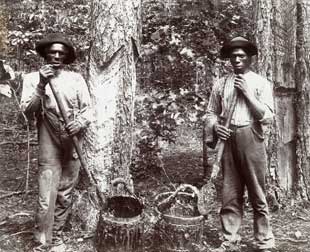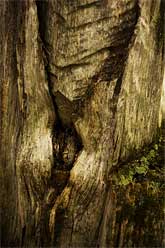

Photographs © Frank Hunter
Hundreds of longleaf pine trees (Pinus palustris), scattered throughout the wooded Weymouth Heights subdivision, are marked with carvings, known as boxes, made by former slaves and their descendants to collect sap for turpentine, pitch, and rosin. In 1904, when Pennsylvania industrialist James Boyd purchased the land, landscape architect Alfred Yeomans, incorporated the old-growth trees into his design for the Weymouth Heights subdivision. Threats to the site include fire suppression, logging, and urban development, and most importantly, lack of public awareness of the cultural and ecological value of the boxed pines.
History
The area tract now known as Weymouth Heights was formerly named Shaw’s Ridge after the immigrant family who worked the forest with their slaves as a tar and turpentine plantation. The “Boxed Pines of Weymouth" are longleaf pine trees (Pinus palustris) marked with V-shaped cuts made by former slaves or their descendants, to let loose the flow of sap collected for turpentine, pitch and rosin. This viscous fluid bled down the trees into deep gashes, known as "boxes," that were carved into the base of the trunks. Hundreds of these trees remain in Weymouth Heights, composing an undocumented, yet significant Scottish-American/African-American cultural landscape dating from the second half of the 19th century.

Sap is collected from the longleaf pine trees circa 1895.
In 1904, Pennsylvania industrialist James Boyd purchased the land, making it part of his Country Place Era estate, Weymouth. At that time, the region was working to overcome the devastations of post-Civil War clear-cutting that, by the turn of the 20th century, had left a wasteland. Weymouth encompassed the region's last stand of original longleaf pine forest that once covered the southeastern coastal plain. Boyd called upon his nephew, landscape architect Alfred Yeomans, to develop the Weymouth Heights subdivision and incorporate the trees. Yeomans’ layout featured curving streets that wrapped around large wooded lots. As a result, many of the old-growth trees survive today scattered throughout the wooded Weymouth Heights subdivision and in the adjacent Weymouth Woods Sandhills Nature Preserve.
Spearheaded by Friends of Weymouth Landscape Committee (WLC), The North Carolina Chapter of The Nature Conservancy, Preservation North Carolina, The Sandhills Council of Garden Clubs, Sandhills Natural History Society, The Southern Pines Garden Club and Sustainable Sandhills, work to encourage a respect for and preservation of this unique living heritage has been ongoing. As a result of these efforts, the new 20-year comprehensive plan for the town includes sustaining this cultural landscape. The trees stand today as a reminder of the history of Southern Pines, from the days of slavery supported plantations to its current role as a recreational destination, and can continue to tell this story to future generations.
The V-shaped marks remain on hundreds of trees within
the subdivision. Photo by Ray Owen.
Threat
The longleaf pine ecosystem is considered endangered globally, with less than 3% of the original 93 million acres remaining. Early published accounts show Weymouth Heights included in the old growth tract, however no studies have been conducted in the urban forest to learn the age of the trees, or ascertain habitat integrity. It is entirely possible that some of the longleaf pines found in the subdivision are among the worlds oldest, with trees documented in the adjoining nature preserve as old as 460 years. While tree preservation is encouraged by the town, there are no municipal ordinances governing the destruction of trees on private property. Threats to the site include fire suppression, logging and urban development. The lack of public awareness of the cultural and ecological value of the boxed pines might be the biggest factor in determining their future survival.


